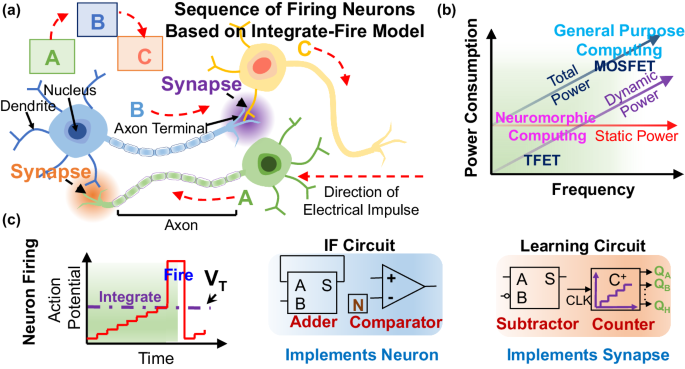2024-06-24 カリフォルニア大学サンタバーバラ校(UCSB)
◆この問題に対処するため、ニューロモルフィック(NM)コンピューティングが登場しました。これは、低消費電力のニューロンが並列処理を行う人間の脳の構造と操作を模倣することで、脳に近いエネルギー効率を目指す技術です。バネルジー教授と共同研究者は、2D遷移金属カルコゲナイドを使用したトンネル場効果トランジスタ(TFET)を用いた超省エネプラットフォームを提案しており、これによりチップのエネルギー消費を人間の脳と比較して約100倍以内に抑えることが可能になるとしています。
<関連情報>
- https://news.ucsb.edu/2024/021528/researchers-propose-next-platform-brain-inspired-computing
- https://www.nature.com/articles/s41467-024-46397-3
2D-TMDトンネルFETが実現するニューロモーフィック・コンピューティングのための超エネルギー効率ハードウェア・プラットフォーム An ultra energy-efficient hardware platform for neuromorphic computing enabled by 2D-TMD tunnel-FETs
Arnab Pal,Zichun Chai,Junkai Jiang,Wei Cao,Mike Davies,Vivek De & Kaustav Banerjee
Nature Communications Published:22 April 2024
DOI:https://doi.org/10.1038/s41467-024-46397-3

Abstract
Brain-like energy-efficient computing has remained elusive for neuromorphic (NM) circuits and hardware platform implementations despite decades of research. In this work we reveal the opportunity to significantly improve the energy efficiency of digital neuromorphic hardware by introducing NM circuits employing two-dimensional (2D) transition metal dichalcogenide (TMD) layered channel material-based tunnel-field-effect transistors (TFETs). Our novel leaky-integrate-fire (LIF) based digital NM circuit along with its Hebbian learning circuitry operates at a wide range of supply voltages, frequencies, and activity factors, enabling two orders of magnitude higher energy-efficient computing that is difficult to achieve with conventional material and/or device platforms, specifically the silicon-based 7 nm low-standby-power FinFET technology. Our innovative 2D-TFET based NM circuit paves the way toward brain-like energy-efficient computing that can unleash major transformations in future AI and data analytics platforms.



